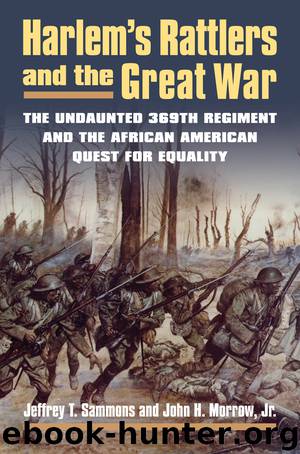Harlem's Rattlers and the Great War by Jeffrey T. Sammons

Author:Jeffrey T. Sammons
Language: eng
Format: epub
Publisher: University Press of Kansas
Published: 2015-08-17T16:00:00+00:00
11
The Big Push
Offensives in Champagne/Meuse-Argonne
and the Capture of Séchault, September 7–October 4, 1918
In the afternoon of September 7, a French motorcycle courier decelerated in front of 369th regimental headquarters in a cloud of dust, bringing orders for the unit to move out early the next morning. After a day’s march of 20 miles, a truck convoy ferried the men back toward the front on the night of September 9.1 Little did they know that they were about to participate in the climactic Franco-American battles of World War I, the contiguous French offensive in Champagne and the American offensive in the Meuse-Argonne.
The 369th relieved the French 215th Infantry Regiment of the 161st Division during the nights of September 10–12. Major Little’s 1st Battalion entered the first line of trenches in subsector Beausejour—probably a French attempt at humor, via a corruption of the term Beau Séjour (beautiful sojourn)—which formed a horseshoe. The unit took control of the right side of a salient, and the French battalion on its left defended the left side of the parallel front lines. Little received a trench mortar unit and an additional machine-gun company for support.2
Little further requested that the departing French battalion commander’s adjutant remain as adviser for twenty-four hours. That afternoon, the 1st Battalion received a warning to expect a German attack in the night. Little and the adjutant walked the subsector, assuring themselves of liaison with the French on their left and of Capt. Frederick Cobb’s 2nd Battalion behind them in support. The night of September 12, the Germans planned to welcome the 369th in their traditional manner—with an attack.3
Just after 6:00 that evening, the Germans fired a mortar barrage of gas canisters into the American lines and then unleashed a violent hour-long series of continuous artillery barrages to cover their advancing troops, the approach trenches, and the rear of the American front to prevent any reinforcement. The shock of an exploding shell knocked Little over, stunning him and cracking two of his ribs. The Americans repulsed the attack and riposted with a strong patrol, which took prisoners.4
When two “very large” German prisoners appeared at Little’s battalion headquarters, where the major lay on his cot in pain, his chest tightly bandaged, the grins on their faces initially panicked him into thinking that they were about to capture him. Then, a small soldier from D Company peered around his two captives, his rifle muzzle in the small of the back of one of the prisoners. A very relieved Little inquired about the fight.5 The soldier reported that his patrol under 2nd Lt. Ernest McNish had successfully ambushed a German patrol and shot some, and as the other Germans ran away, they closed to take the rest prisoners. McNish had told the soldier to bring back five large German prisoners alone. Concerned with the odds and their size, the soldier confessed to Major Little that he decided “he’d better clean them out a bit.”6 Killing prisoners in cold or hot blood frequently occurred during the war, and in this case, the young soldier had calculatedly “thinned” their ranks.
Download
This site does not store any files on its server. We only index and link to content provided by other sites. Please contact the content providers to delete copyright contents if any and email us, we'll remove relevant links or contents immediately.
| African-American Studies | Asian American Studies |
| Disabled | Ethnic Studies |
| Hispanic American Studies | LGBT |
| Minority Studies | Native American Studies |
Cecilia; Or, Memoirs of an Heiress — Volume 1 by Fanny Burney(32434)
Cecilia; Or, Memoirs of an Heiress — Volume 2 by Fanny Burney(31871)
Cecilia; Or, Memoirs of an Heiress — Volume 3 by Fanny Burney(31852)
The Great Music City by Andrea Baker(31348)
We're Going to Need More Wine by Gabrielle Union(18967)
All the Missing Girls by Megan Miranda(15568)
Pimp by Iceberg Slim(14393)
Bombshells: Glamour Girls of a Lifetime by Sullivan Steve(13972)
Talking to Strangers by Malcolm Gladwell(13222)
Norse Mythology by Gaiman Neil(13204)
Fifty Shades Freed by E L James(13157)
For the Love of Europe by Rick Steves(12977)
Mindhunter: Inside the FBI's Elite Serial Crime Unit by John E. Douglas & Mark Olshaker(9200)
Crazy Rich Asians by Kevin Kwan(9167)
The Lost Art of Listening by Michael P. Nichols(7406)
Enlightenment Now: The Case for Reason, Science, Humanism, and Progress by Steven Pinker(7228)
The Four Agreements by Don Miguel Ruiz(6630)
Bad Blood by John Carreyrou(6552)
Weapons of Math Destruction by Cathy O'Neil(6143)
